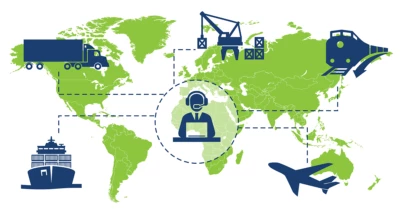The phenomenal growth of eCommerce has transformed business paradigms across the globe in the last couple of decades. When it comes to cross-border shipping, eCommerce giants have set benchmarks while overcoming potential challenges.
Do you know that cross-border Ecommerce is all set to hit the magical $4 trillion mark by 2027? This marks a phenomenal CAGR of 27.1%, considering that the figure stood at just $562.1 billion in 2018. While the numbers look impressive, eCommerce players have put in a lot of effort streamlining cross-border shipping.
After all, cross-border shipping in ecommerce presents online retailers to expand their clientele beyond domestic borders. As you brace up to explore fresh demographics and markets, it pays to understand the challenges in cross-border shipping.
Understanding cross-border shipping challenges
Before taking you through the challenges that might throw your ambitious marketing plans out of track, let’s take a look at this statistic
Source: statista.com
This graph presents eCommerce cross-border shipping in comparison to the overall percentage of eCommerce shipments across the globe. In 2016, the cross-border market for online retailers had a 15% share, which rose to 22% in 2022.
Besides, Statista conducted a study involving 765 e-retailers to identify challenges in cross-border shipping. Have a look at the key hurdles they identified across different categories.
- Problems to adhere to regulatory norms: 51%
- Inventory tracking of products shipped abroad: 46%
- Fulfilling customer’s demands with deliveries: 43%
- International logistics: 30%
- Returning products to a different country: 24%
Prime challenges eCommerce brands face in cross-border shipping
Thanks to technological sophistication transforming eCommerce in the last decade, online retailers can seamlessly reach out to overseas customers. That’s what gave them an advantage over brick-and-mortar stores. With a robust cross-border eCommerce strategy, retailers are looking forward to explore fresh avenues abroad.
Let’s take a look at the prime challenges in cross-border shipping before we bail you out with viable solutions for the same.
1. Regulations and restrictions in international shipping
Although eCommerce business leaders are privileged to access a singular international market, it’s easy to run into demographic restrictions. This makes it challenging to come up with a single strategy to promote international sales and shopping. It pays to be wary of necessary permits, documentation, customs duties, and labeling formalities.
For example, eCommerce firms cannot ship flammable, radioactive, explosive, or any dangerous item with their weights exceeding 66 pounds to Canada.
Likewise, the US has come up with a list of restricted items that eCommerce companies cannot ship.
So, while dealing with specific products, eCommerce business leaders and marketers need to understand these complexities. Respecting the legalities would help in streamlining your business.
2. Complex documentation processes
Do you know that eCommerce retailers in even friendly countries like Canada and the US need to carry out extensive formalities? Documentation processes can be time-consuming and expensive while handling cross-border shipping.
Let’s take a look at what shipping online products between these two countries involves.
- Shipments from the US entering Canada require a Canada customs invoice (CI1).
- The process involves a Bill of Landing that contains the names of items shipped. It also states the product size, weight, and contact details.
- Attached to this bill, there should be a commercial invoice containing detailed information on the shipment.
- Cross-border shipping after International online shopping also requires a signed delivery proof, validating that the intended party received the shipment.
- The NAFTA regulation compliance also requires a Certificate of Origin.
Now, have you factored in the expenses associated with accomplishing these formalities?
3. Lack of expertise in the local market
The lack of research on international demographics often leads to corresponding challenges with cross-border shipping. Well, while strategizing your cross-border marketing plan, you invest time and resources on research. Why not deploy the same approach while working on the freight movement?
Shipping issues crop up unexpectedly, and these troubles can be weirdly varied from one region to the next. Once eCommerce analysts identify these patterns, they can strategize countermeasures accordingly. Consider the same tactic while configuring payment modes.
Besides, it’s crucial to monitor online shopping trends on special days or special categories like pants that go well with black shirt. During festivals or offer seasons, the demand for delivery partners undergoes a spike. Unless you partner with a delivery agent capable of scaling their services, the chances of a bottleneck are pretty high. The last thing eCommerce retailers expect is a backlash when they fail to fulfill promised delivery deadlines
Have a look at this statistic pointing out the major delivery issues that can put your customers away.
Graph showing delays in deliveries continue to be the most common delivery issue faced by eCommerce brands.
4. Managing logistics and supply chains
Being a player in the global eCommerce segment, you know how complicated logistics management can be. Particularly, eCommerce retailers struggle to streamline processes when it comes to managing in-transit goods, tracking orders, and meeting delivery timeframes. Border delays and multicarrier handoffs continue to bug cross-border shipping processes. For example, if you own an mobile app development company in Delhi, there are certain tools and resources you need like coding employees, appropriate IDEs, system with accurate specifications, etc. Similarly for an global ecommerce company, there are certain logistics that are mandatory for a company to have and maintain.
5. Basket abandonment
As you explore customer bases beyond the border, it pays to focus on localized issues with shipment. After all, you need to deliver a domestic shopping experience to your international clientele. In this context, we would mention localizing currencies, languages, and even customer service functions.
Even a slight deviation from this essence of localization can backfire for eCommerce retailers, as they fail to convert buyers. In an effort to streamline your cross-border shipping mechanism, focus on a powerful localized checkout mechanism. Partnering with specialized logistics and technology providers can tailor the customer experience to perfection.
6. Returning goods to a different country
With globalization, customers expect flawless return policies from international eCommerce brands. To assure a satisfying online shopping experience, make sure to offer free shipping and returns.
A customer-friendly approach to formulating your shipping and return policies ensures that you don’t lose repeat customers. At the same time, proper inventory planning takes care of your returned goods.
One of the pain points of eCommerce retailers is their limited focus and visibility over the return process. Unless you come up with a transparent mechanism, returns can turn out to be a painstaking and expensive ordeal.Delays and longer freight movement processes are often associated with returned products. Along with these, you have tax implications, which can take a toll on your revenue.
Resolving cross-border shipment issues: How to go about it?
1. Managing cross-border shipments
What’s your counter strategy to address issues like basket abandonment and international returns?
Successful eCommerce brands have deployed a two-pronged approach to handle the supply chain challenge. Apart from partnering with the right delivery companies for cross-border shipping, they also prioritize localized fulfillment. Compared to local shipment, cross-border shipment involves more paperwork.
With localized fulfillment, you need to have your inventory stocked in local warehouses. These goods are to be delivered domestically to customers from these facilities. This can significantly mitigate issues like delays in freight movement across borders.
Having logistics control towers or multi carrier software platforms in place can also simplify these challenges. This involves choosing the right plan routes and shipping partners, besides preparing export parcels before passing them on to the exporter. Working on international commercial terms management should simplify these issues. This way, eCommerce companies can reduce instances of basket abandonment.
2. Collaborate with a return intermediate
Streamlining the return mechanism of shipped goods across borders requires eCommerce business minds to collaborate with end-to-end returns intermediates. As a business owner, you would prioritize protecting your costs, just as you give your customers the liberty to stick to their preferences.
Successful eCommerce brands work with these return intermediates to facilitate parcel tracking. Deploying advanced tools, they ensure transparency and visibility in tracking supply chains. Ultimately, you need to strategize an effective cost optimization system like salvaging products, exchanging, or selling damaged products as scrap. Make sure to factor in these losses when you equate your profit margins to remain on the gaining end.
3. Ensure cost and taxation transparency
Given that more than 50% of cross-border shipping issues stem from regulatory complications, it pays to ensure cost and tax transparency. Remember, people prefer purchasing merchandise from foreign eCommerce brands simply because of their convenience and price benefits. This implies that they are comfortable shelling out the price after you factor in duty fees, tax, shipping expenses, and carrier fees into the selling price of the product. All these elements influence the overall landed cost that your customers are forking out.
To ensure compliance, be transparent and honest with the cost-break up. Customers should have complete knowledge of the overall landed cost when they make a purchase.Also, eCommerce brands should respect international regulatory norms while selling their merchandise abroad.
4. Automate shipment and delivery processes
Tackling logistics hurdles during cross-border shipping calls for automation tools. Suppose, you sell a particular product to multiple overseas markets. Your website may have the same information in different languages. Why not use an automation tool for standardizing all the actions?
Using a single tool, eCommerce brands have been controlling mail services, couriers, accounting, and warehousing systems across the globe. With this approach, streamlining operations and cross-border shipping would be easy.
Wrapping up
Information transparency, localization, and working closely with third-party logistics providers define the success formula for eCommerce brands. Cross-border shipping has been one of the pain points for online retailers. However, as you continue to map larger demographics, streamlining your delivery mechanism can propel you closer to success.
Now that we have addressed all the challenges of international shipping and recommended practical solutions, how about strategizing your logistics and shipments on these lines.




